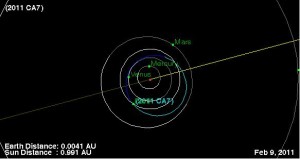Today, asteroid 2011 CA7 is said to zoom past Earth at over 64,300 feet. The 9.5 foot rock will barely miss us –by universe standards– as it hurls across our solar system.
Last Friday, asteriod 2011 CQ 1 passed Earth at over 3,400 feet. four feet wide, 2011 CQ 1 was small enough to probably disintegrate when falling towards Earth. The article on UPI.com stated that both of these asteroids would not survive the trip through our atmosphere and break apart before reaching us.
That’s all fine and dandy. Then I read that Russian scientists recently announced that a bigger and badder asteroid could actually hit us in 2036. The 99942 Apophis asteroid is said to have a 1 in 250,000 chance at possibly ending human life here on Earth.
I’m not a gambling man, but these odds don’t really pacify me.
In fact, here is a video of what “could be”. Have a nice day guys!
Full source: UPI
10 commentsPASADENA, Calif., Feb. 9 (UPI) — A car-size asteroid will pass near Earth Wednesday, U.S. scientists said, while one bigger than two football fields might hit Earth in 18 years.
The 2011 CA7 asteroid, measuring 9 1/2 feet across, will be 64,300 miles overhead Wednesday, reaching its closest point around 2:25 p.m. EST, said NASA’s Jet Propulsion Laboratory in Pasadena, Calif.
A 4-foot-wide asteroid called 2011 CQ 1 sailed 3,400 miles above Earth Friday, the National Aeronautics and Space Administration said.
Both asteroids are so small that even if they did get pulled to Earth, they would not survive the fiery trip to the surface and would break up or burn up on the way down, Space.com said.
By contrast, an asteroid larger than two football fields could strike Earth April 13, 2036, Russian scientists said, contradicting NASA scientists, who said in 2009 the 99942 Apophis asteroid had nearly no chance of hitting Earth on that date.
Apophis, which NASA scientists also said has a 2.7 percent change of smashing into Earth in 2029, will get as close to Earth as about 23,000 miles April 13, 2029 — and “its likely collision with Earth may occur on April 13, 2036,” Professor Leonid Sokolov of St. Petersburg State University said.
Still, the chance of a collision is extremely slim because scientists will develop ways of preventing it, Sokolov said.
“Our task is to consider various alternatives and develop scenarios and plans of action depending on the results of further observations of Apophis,” Sokolov told Russian state-owned news agency RIA Novosti.
Sokolov and his colleagues are “technically” correct, Donald Yeomans, head of NASA’s Near-Earth Object Program Office, told The Christian Science Monitor.
“There is a chance (of a collision) in 2036,” but the chance is 1 in 250,000, he said.
The Russian calculations are based on the 900-foot Apophis traveling through a “gravitational keyhole” as it passes Earth in 2029. The gravitational keyhole is a precise region in space, about 2,000 feet across, in which Earth’s gravity could tweak Apophis’s path and set it up for the April 13, 2036, impact, scientists from both countries said.
“If it goes through what we call a keyhole during that close Earth approach (in 2029) … then it will indeed be perturbed just right so that it will come back and smack Earth on April 13, 2036,” Yeomans said.
But the chances the asteroid will go through the keyhole are “minuscule,” he told the newspaper. And scientists are working to minimize the chances even further.
Apophis will make a fairly close approach to Earth late next year and in early 2013, Yeomans said. And if the asteroid seems headed on a destructive path, NASA will devise a scheme and the machinery needed to change its orbit, decreasing the probability of a 2036 collision to zero, Yeomans said.
Read more: http://www.upi.com/Science_News/2011/02/09/Car-size-asteroid-nears-Earth-Wednesday/UPI-66801297240200/#ixzz1DUJLMLe8





